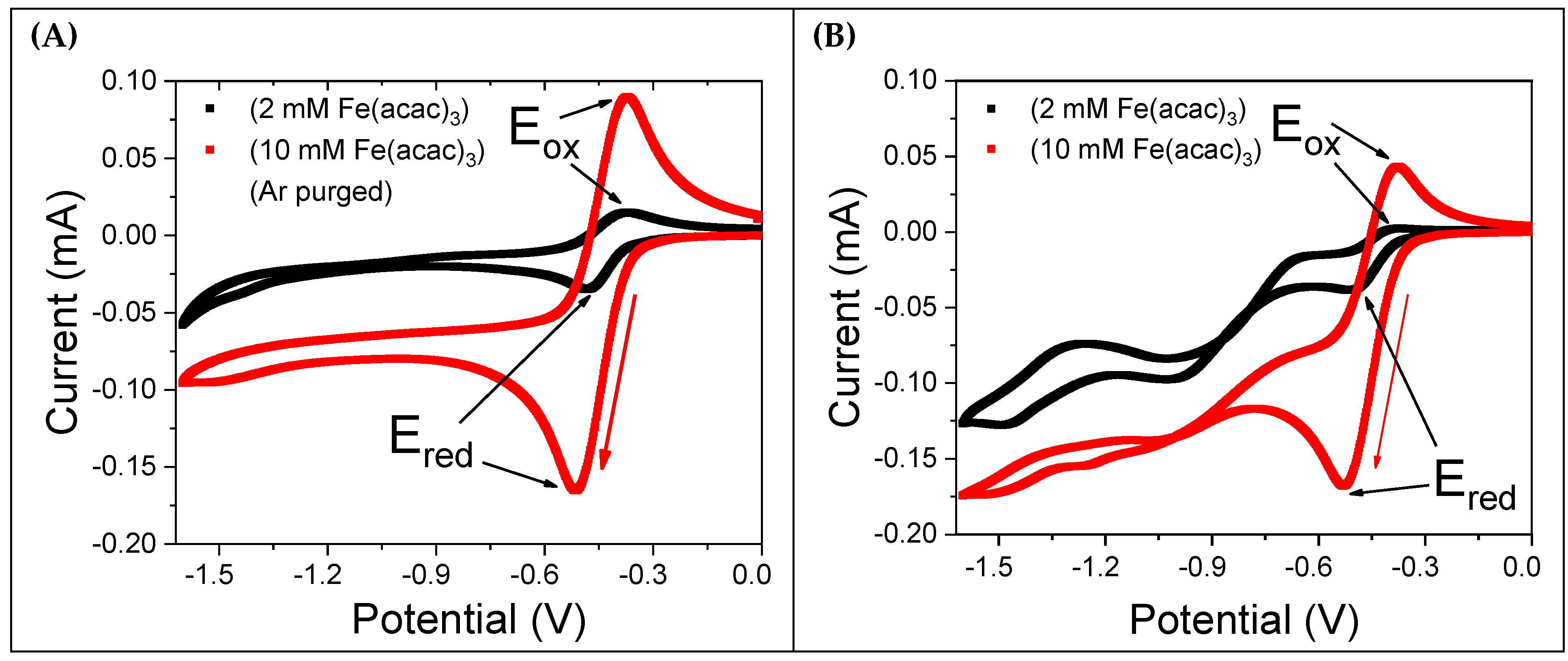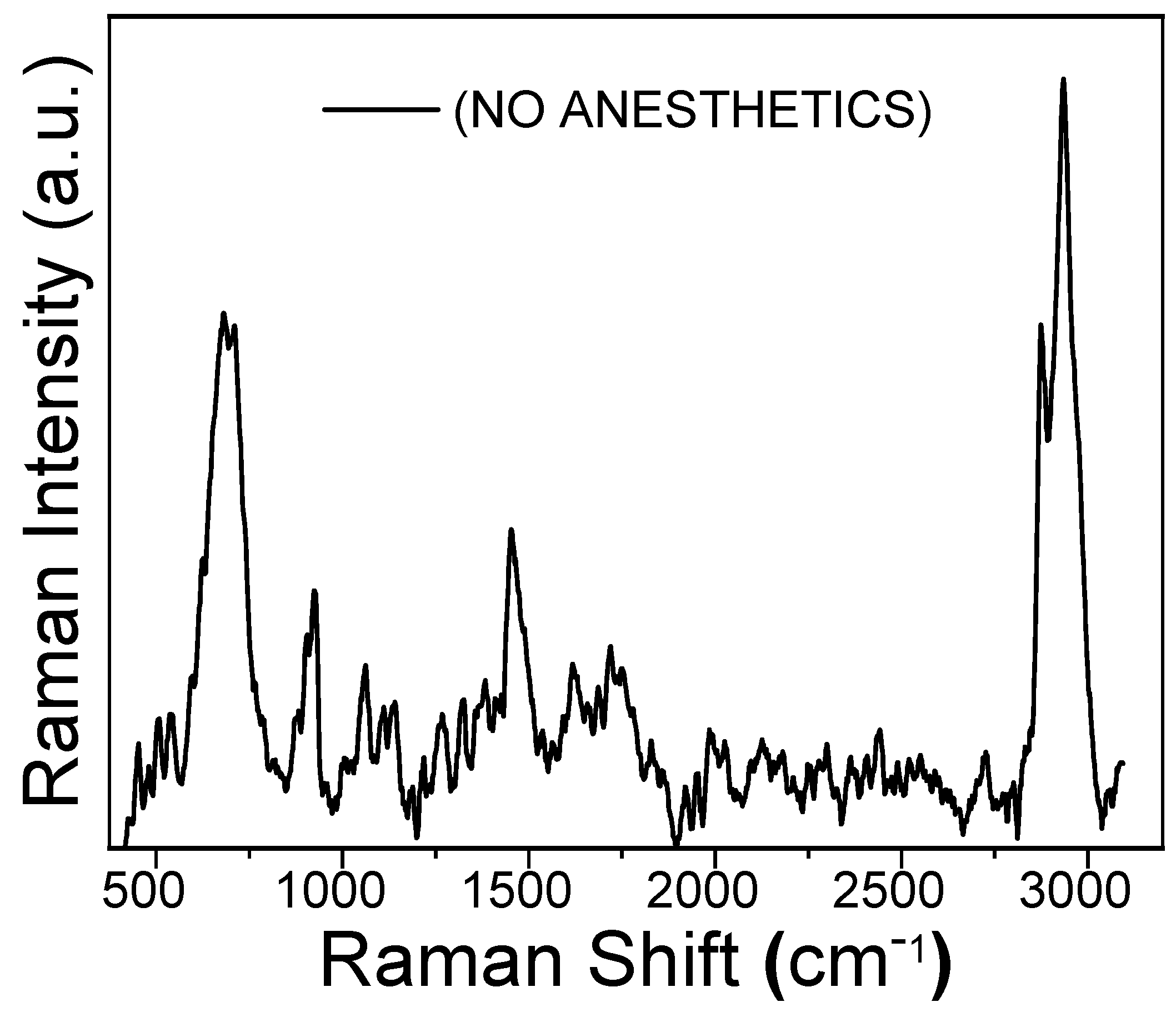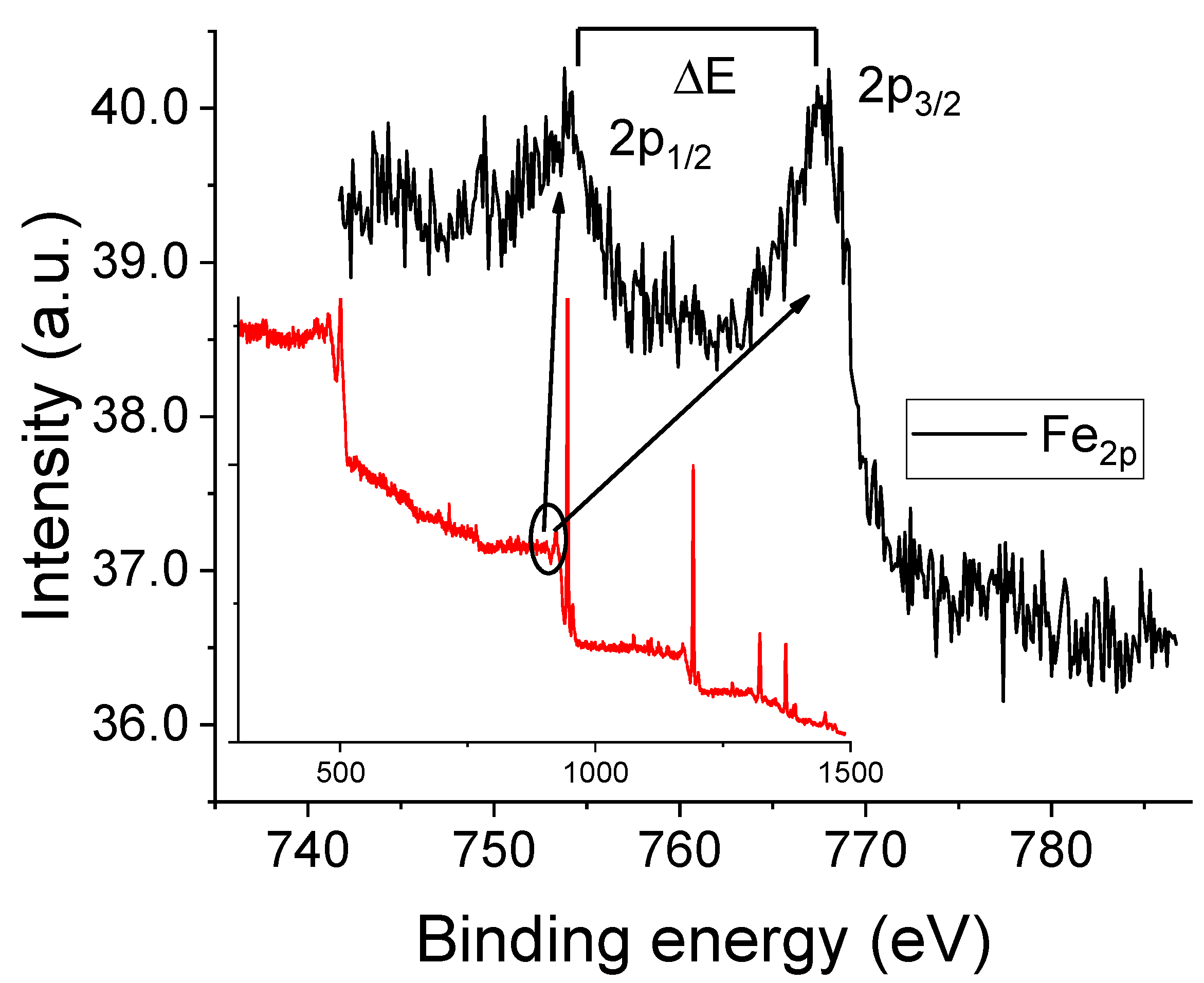Sevoflurane and Desflurane Spin–Decoherence Effect on Fe(III)acetylacetonate Redox Process
Abstract
1. Introduction
2. Results and Discussion
2.1. Cyclic Voltammetry Analysis
2.1.1. Influence of Dissolved Oxygen
2.1.2. Influence of Anesthetics
2.2. Raman and XPS Spectra of the Film Formed upon CV Cycling
3. Spin Mediated ORR-Anesthetics Interaction
3.1. Electrochemical Mechanism
3.2. Concentration-Dependent Electrochemical Activity of Fe(acac)3
3.3. Thick Film Formation Under Repeated Cycling
3.4. Influence of Sevoflurane and Desflurane on the Electrochemical Behavior of Fe(acac)3
4. Materials and Methods
4.1. Chemicals
4.2. Electrochemical Experiments
4.3. X-Ray Photoelectron Spectroscopy (XPS)
4.4. Raman Spectroscopy
5. Conclusions
Supplementary Materials
Author Contributions
Funding
Institutional Review Board Statement
Informed Consent Statement
Data Availability Statement
Conflicts of Interest
References
- Costentin, C.; Robert, M.; Savéant, J.-M. Concerted Proton-Electron Transfers: Electrochemical and Related Approaches. Acc. Chem. Res. 2010, 43, 1019–1029. [Google Scholar] [CrossRef]
- Conradie, M.M. UV-Vis Spectroscopy, Electrochemical and DFT Study of Tris(β-Diketonato)Iron(III) Complexes with Application in DSSC: Role of Aromatic Thienyl Groups. Molecules 2022, 27, 3743. [Google Scholar] [CrossRef]
- Compton, R.G.; Banks, C.E. Voltammetry at Microelectrodes. In Understanding Voltammetry; World Scientific (Europe): London, UK, 2024; pp. 165–204. ISBN 978-1-80061-597-7. [Google Scholar]
- Ronzani, M.; Woyke, S.; Mair, N.; Gatterer, H.; Oberacher, H.; Plunser, D.; Haller, T.; Ströhle, M.; Rugg, C. The Effect of Desflurane, Isoflurane and Sevoflurane on the Hemoglobin Oxygen Dissociation Curve in Human Blood Samples. Sci. Rep. 2022, 12, 13633. [Google Scholar] [CrossRef]
- Gazzola, G.; Pasinato, S.; Fantin, M.; Braidi, N.; Tubaro, C.; Durante, C.; Isse, A.A. Electrochemical Investigation of Iron-Catalyzed Atom Transfer Radical Polymerization. Molecules 2022, 27, 6312. [Google Scholar] [CrossRef]
- Morgan, P.G.; Hoppel, C.L.; Sedensky, M.M. Mitochondrial Defects and Anesthetic Sensitivity. Anesthesiology 2002, 96, 1268–1270. [Google Scholar] [CrossRef]
- Campagna, J.A.; Miller, K.W.; Forman, S.A. Mechanisms of Actions of Inhaled Anesthetics. N. Engl. J. Med. 2003, 348, 2110–2124. [Google Scholar] [CrossRef]
- Sang, Y.; Tassinari, F.; Santra, K.; Zhang, W.; Fontanesi, C.; Bloom, B.P.; Waldeck, D.H.; Fransson, J.; Naaman, R. Chirality Enhances Oxygen Reduction. Proc. Natl. Acad. Sci. USA 2022, 119, e2202650119. [Google Scholar] [CrossRef] [PubMed]
- Gupta, A.; Sang, Y.; Fontanesi, C.; Turin, L.; Naaman, R. Effect of Anesthesia Gases on the Oxygen Reduction Reaction. J. Phys. Chem. Lett. 2023, 14, 1756–1761. [Google Scholar] [CrossRef] [PubMed]
- Gupta, A.; Kumar, A.; Bhowmick, D.K.; Fontanesi, C.; Paltiel, Y.; Fransson, J.; Naaman, R. Does Coherence Affect the Multielectron Oxygen Reduction Reaction? J. Phys. Chem. Lett. 2023, 14, 9377–9384. [Google Scholar] [CrossRef] [PubMed]
- Melegari, G.; Gupta, A.; Ferrari, C.; Kumari, N.; Mishra, S.; Giuliani, E.; Barbieri, A.; Fontanesi, C. The Role of Electrochemistry in Solving the Mystery of the Relationship between Molecular Structure and Anaesthetic Potency. Curr. Opin. Electrochem. 2025, 50, 101652. [Google Scholar] [CrossRef]
- Pauling, L.; Coryell, C.D. The Magnetic Properties and Structure of the Hemochromogens and Related Substances. Proc. Natl. Acad. Sci. USA 1936, 22, 159–163. [Google Scholar] [CrossRef]
- Pauling, L.; Coryell, C.D. The Magnetic Properties and Structure of Hemoglobin, Oxyhemoglobin and Carbonmonoxyhemoglobin. Proc. Natl. Acad. Sci. USA 1936, 22, 210–216. [Google Scholar] [CrossRef]
- Bren, K.L.; Eisenberg, R.; Gray, H.B. Discovery of the Magnetic Behavior of Hemoglobin: A Beginning of Bioinorganic Chemistry. Proc. Natl. Acad. Sci. USA 2015, 112, 13123–13127. [Google Scholar] [CrossRef] [PubMed]
- Turin, L.; Skoulakis, E.M.C.; Horsfield, A.P. Electron Spin Changes during General Anesthesia in Drosophila. Proc. Natl. Acad. Sci. USA 2014, 111, E3524–E3533. [Google Scholar] [CrossRef]
- Kobayashi, A.; Kasahara, M.; Koshika, K.; Akiike, Y.; Matsuura, N.; Ichinohe, T. Remifentanil Infusion during Desflurane Anesthesia Reduces Tissue Blood Flow While Maintaining Blood Pressure and Tissue Oxygen Tension in the Masseter Muscle and Mandibular Bone Marrow. J. Vet. Med. Sci. 2021, 83, 62–68. [Google Scholar] [CrossRef] [PubMed]
- Totoiu, C.A.; Follmer, A.H.; Oyala, P.H.; Hadt, R.G. Probing Bioinorganic Electron Spin Decoherence Mechanisms with an Fe2S2 Metalloprotein. J. Phys. Chem. B 2024, 128, 10417–10426. [Google Scholar] [CrossRef] [PubMed]
- Chakrabarti, M.H.; Brandon, N.P.; Mjalli, F.S.; Bahadori, L.; Al Nashef, I.M.; Hashim, M.A.; Hussain, M.A.; Low, C.T.J.; Yufit, V. Cyclic Voltammetry of Metallic Acetylacetonate Salts in Quaternary Ammonium and Phosphonium Based Deep Eutectic Solvents. J. Solut. Chem. 2013, 42, 2329–2341. [Google Scholar] [CrossRef]
- Zierkiewicz, W.; Wieczorek, R.; Hobza, P.; Michalska, D. Halogen Bonded Complexes between Volatile Anaesthetics (Chloroform, Halothane, Enflurane, Isoflurane) and Formaldehyde: A Theoretical Study. Phys. Chem. Chem. Phys. 2011, 13, 5105–5113. [Google Scholar] [CrossRef]
- Minaev, B.F.; Ågren, H.; Minaeva, V.O. Spin-Orbit Coupling in Enzymatic Reactions and the Role of Spin in Biochemistry. In Handbook of Computational Chemistry; Leszczynski, J., Ed.; Springer: Dordrecht, The Netherlands, 2016; pp. 1–31. ISBN 978-94-007-6169-8. [Google Scholar]
- Minaev, B. The Spin of Dioxygen as the Main Factor in Pulmonology and Respiratory Care. Arch. Pulmonol. Respir. Care 2022, 8, 028–033. [Google Scholar] [CrossRef]
- Franco, C.; Olmsted, J. Photochemical Determination of the Solubility of Oxygen in Various Media. Talanta 1990, 37, 905–909. [Google Scholar] [CrossRef]
- Gunawardana, B.; Singhal, N.; Swedlund, P. Degradation of Chlorinated Phenols by Zero Valent Iron and Bimetals of Iron: A Review. Environ. Eng. Res. 2011, 16, 187–203. [Google Scholar] [CrossRef]
- Fox, B.G.; Shanklin, J.; Ai, J.; Loehr, T.M.; Sanders-Loehr, J. Resonance Raman Evidence for an Fe-O-Fe Center in Stearoyl-ACP Desaturase. Primary Sequence Identity with Other Diiron-Oxo Proteins. Biochemistry 1994, 33, 12776–12786. [Google Scholar] [CrossRef] [PubMed]
- Allen, G.C.; Harris, S.J.; Jutson, J.A.; Dyke, J.M. A Study of a Number of Mixed Transition Metal Oxide Spinels Using X-Ray Photoelectron Spectroscopy. Appl. Surf. Sci. 1989, 37, 111–134. [Google Scholar] [CrossRef]
- Fujii, T.; de Groot, F.M.F.; Sawatzky, G.A.; Voogt, F.C.; Hibma, T.; Okada, K. In Situ XPS Analysis of Various Iron Oxide Films Grown by NO2-Assisted Molecular-Beam Epitaxy. Phys. Rev. B 1999, 59, 3195–3202. [Google Scholar] [CrossRef]





| Scan Rate [mV/s] | [V] | [V] | [mV] | |
|---|---|---|---|---|
| Ar purged | 50 | −0.478 | −0.386 | 93 |
| 100 | −0.513 | −0.390 | 123 | |
| Saturate with O2 (in equilibrium with air) | 50 | −0.510 | −0.365 † | 145 |
| 100 | −0.532 | −0.370 | 163 |
Disclaimer/Publisher’s Note: The statements, opinions and data contained in all publications are solely those of the individual author(s) and contributor(s) and not of MDPI and/or the editor(s). MDPI and/or the editor(s) disclaim responsibility for any injury to people or property resulting from any ideas, methods, instructions or products referred to in the content. |
© 2025 by the authors. Licensee MDPI, Basel, Switzerland. This article is an open access article distributed under the terms and conditions of the Creative Commons Attribution (CC BY) license (https://creativecommons.org/licenses/by/4.0/).
Share and Cite
Kumari, N.; Severini, A.; Borghi, M.; Montecchi, M.; Pasquali, L.; Colombini, E.; Melegari, G.; Barbieri, A.; Giuliani, E.; Innocenti, M.; et al. Sevoflurane and Desflurane Spin–Decoherence Effect on Fe(III)acetylacetonate Redox Process. Molecules 2025, 30, 4341. https://doi.org/10.3390/molecules30224341
Kumari N, Severini A, Borghi M, Montecchi M, Pasquali L, Colombini E, Melegari G, Barbieri A, Giuliani E, Innocenti M, et al. Sevoflurane and Desflurane Spin–Decoherence Effect on Fe(III)acetylacetonate Redox Process. Molecules. 2025; 30(22):4341. https://doi.org/10.3390/molecules30224341
Chicago/Turabian StyleKumari, Neha, Andrea Severini, Mauro Borghi, Monica Montecchi, Luca Pasquali, Elena Colombini, Gabriele Melegari, Alberto Barbieri, Enrico Giuliani, Massimo Innocenti, and et al. 2025. "Sevoflurane and Desflurane Spin–Decoherence Effect on Fe(III)acetylacetonate Redox Process" Molecules 30, no. 22: 4341. https://doi.org/10.3390/molecules30224341
APA StyleKumari, N., Severini, A., Borghi, M., Montecchi, M., Pasquali, L., Colombini, E., Melegari, G., Barbieri, A., Giuliani, E., Innocenti, M., Roncaglia, F., Kumar, T. D., & Fontanesi, C. (2025). Sevoflurane and Desflurane Spin–Decoherence Effect on Fe(III)acetylacetonate Redox Process. Molecules, 30(22), 4341. https://doi.org/10.3390/molecules30224341









